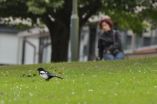(Press-News.org) White flight does not end when residents move from poor urban neighborhoods to the suburbs. An Indiana University study found that white flight from one suburban neighborhood to another occurs when white residents move away from "ethnoburbs," suburban neighborhoods that attract a growing number of middle-class minority residents.
"The sheer force of immigration and suburbanization has resulted in the unmistakable rise of middle-class yet ethnic suburban communities. However, my research shows that despite their distinct middle-class character, ethnoburbs have lost a steady flow of white residents over the past 20 years," said Samuel Kye, author of "Revisiting White Flight and Segregation: The Consequences of Ethnoburbs."
Kye is discussing his study at 2:30 p.m. on Saturday, Aug. 16, at the American Sociological Association's annual meeting in San Francisco.
"The findings suggest that patterns of segregation remain highly active even in these, the most affluent of ethnic neighborhoods," said Kye, a doctoral student in the Department of Sociology in IU Bloomington's College of Arts and Sciences. "Collectively, this raises important questions about the future of America's increasingly diverse metropolitan areas."
Kye's study is one of the first to look at white Americans' response to the influx of suburban ethnic populations. It also is one of the first to use a nationwide sample of census tracts to examine residential trends. His work expands the conversation about ethnic neighborhoods beyond the Chinatowns and other urban "enclaves," where poor residents of similar ethnicity have often lived because they lacked other choices. Studies involving suburbs offer researchers the opportunity to examine where people choose to live.
Rather than safely becoming middle-class melting pots, however, the once majority-white suburbs in Kye's study appeared especially sensitive to the growth and emergence of non-white populations. Levels of "white flight" and segregation attributable to the presence of minority groups were distinctly higher in suburbs than in urban neighborhoods. A silver lining, Kye said, is that the level of suburban segregation for most minority groups had stopped increasing and began instead to decrease from 1990 to 2010 -- except for African American neighborhoods.
Kye said black ethnoburbs were the only communities to continue showing increases in segregation during that same time period.
"This is alarming because although black-white segregation has generally declined over the past 30 to 40 years, blacks still remain the most highly segregated minority group in the U.S. today," he said. "The fact that levels of segregation for blacks continue to grow even in their middle-class communities raises concern about the decline of black/white segregation into the future, especially as America continues to suburbanize and ethnoburbs proliferate in number."
INFORMATION:
Kye can be reached at 267-242-2277 or skye@indiana.edu. For additional assistance, contact Tracy James at 812-855-0084 or traljame@iu.edu.
Ethnoburbs: Segregation in suburbia
2014-08-16
ELSE PRESS RELEASES FROM THIS DATE:
The notion of love can lead to greater acceptance of couples' rights
2014-08-16
SAN FRANCISCO -- An Indiana University study found that how "in love" a romantic couple appears to be is interpreted differently based on the couple's sexual orientation, affecting what formal and informal rights people think that couple deserves.
Long Doan, a doctoral student in the Department of Sociology at IU Bloomington's College of Arts and Sciences, said the study was created to understand how people's attitudes differ based on sexual orientation.
"If you ask what someone thinks of a same-sex couple or what they think of a straight couple, they usually have different ...
New study takes the shine off magpie folklore
2014-08-16
Magpies are not attracted to shiny objects and don't routinely steal small trinkets such as jewellery, according to a new study.
In European culture, it is widely accepted that magpies (Pica pica) are the pilferers of the bird kingdom, unconditionally attracted to sparkly things and prone to pinching them for their nests, almost as a compulsion.
But psychologists at the Centre for Research in Animal Behaviour (CRAB) at the University of Exeter are now countering this folklore, having shown that the species is actually frightened of new and unfamiliar objects, rather ...
Bivalirudin versus heparin in patients planned for coronary stenting
2014-08-16
Boston, MA— Bivalirudin and heparin are two anticoagulant options for patients undergoing coronary stenting for ischemic heart disease. Bivalirudin, a newer anticoagulant, has been touted as being as effective as generic heparin, but with nearly half the rate of bleeding. However, several studies have hinted that, compared with heparin, bivalirudin-based regimens might not protect as well against recurrent heart attacks and might increase the risk of stents clotting off. Moreover, newer studies have questioned whether the reduction in bleeding holds up when tested on more ...
Dopamine replacement associated with impulse control increase in early Parkinson's
2014-08-15
(PHILADELPHIA) – New Penn Medicine research shows that neuropsychiatric symptoms such as depression, anxiety and fatigue are more common in newly diagnosed Parkinson's disease (PD) patients compared to the general population. The study also found that initiation of dopamine replacement therapy, the most common treatment for PD, was associated with increasing frequency of impulse control disorders and excessive daytime sleepiness. The new findings, the first longitudinal study to come out of the Parkinson's Progression Markers Initiative (PPMI), are published in the August ...
Utility of sequence-related amplified polymorphism (SRAP) markers
2014-08-15
Today, many ecological and evolutionary studies depend on a wide range of molecular tools to infer phylogenetic relationships, uncover population structure within species, and track quantitative traits. Agricultural studies use these same tools to improve crop yield and increase resistance to pests and disease.
However, many of these methods—such as amplified fragment length polymorphisms (AFLP), inter-simple sequence repeats (ISSR), and random amplified polymorphic DNA (RAPD)—have technical limitations. These include issues of reproducibility, ambiguity in determining ...
Depression often untreated in Parkinson's disease
2014-08-15
Depression is known to be a common symptom of Parkinson's disease, but remains untreated for many patients, according to a new study by Northwestern Medicine investigators in collaboration with the National Parkinson's Foundation (NPF).
In fact, depression is the most prevalent non-motor symptom of Parkinson's, a chronic neurodegenerative disorder typically associated with movement dysfunction.
"We confirmed suspicion that depression is a very common symptom in Parkinson's disease. Nearly a quarter of the people in the study reported symptoms consistent with depression," ...
Scientists discover interstellar stardust
2014-08-15
We may joke about looking for a needle in a haystack, but that's nothing compared to searching for stardust in a foil! A new paper published in Science reveals that such work has led to the discovery of seven dust particles that are not only out of this world, they're out of this solar system.
The Stardust Interstellar Dust Collector was launched in 1999 in an effort to collect contemporary interstellar dust—dust that has travelled to our solar system from another. The Collector returned in 2006; since then scientists have been combing through blue aerogel and aluminum ...
Credit allocation among researchers determined by new algorithm
2014-08-15
A new algorithm developed at Northeastern's Center for Complex Network Research helps sheds light on how to properly allocate credit.
The research was published this month in Proceedings of the National Academy of Sciences in a paper co-authored by Hua-Wei Shen, a visiting scholar at Northeastern and associate professor at the Institute of Computing Technology at the Chinese Academy of Sciences, and Albert-László Barabási, the Robert Gray Dodge Professor of Network Science and a Distinguished University Professor at Northeastern.
Using ...
New X-ray imaging developed by scientists
2014-08-15
Scientists have developed an x-ray imaging system that enables researchers to see 'live' how effective treatments are for cystic fibrosis.
Published in the American Journal of Respiratory and Critical Care Medicine, the imaging method allows researchers to monitor the effectiveness of a treatment for the life-threatening genetic disorder.
Cystic fibrosis affects many of the body's systems, but most severely the lungs, and currently it can take several months to measure how effective treatment is for the early-fatal lung disease.
Dr Kaye Morgan, lead researcher on ...
'Science' features PRB, WSU, DMC advances in preterm birth
2014-08-15
DETROIT – The Aug. 15 edition of the prestigious journal Science features a major article about the most important problem in obstetrics: preterm labor. The article, "Preterm labor: one syndrome, many causes," delivers a powerful message: preterm birth is not one condition, but many, and provides a framework for meeting this challenge.
"There are 15 million preterm babies born annually, and the condition affects 5 percent to 15 percent of all pregnancies, with the highest rates in North America and Africa. Prematurity is the leading cause of infant death up to age 1and ...



